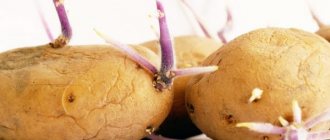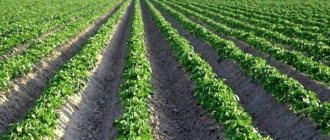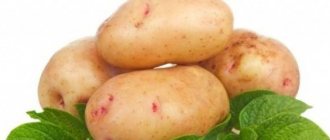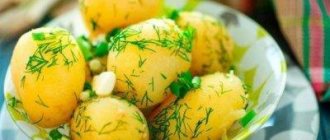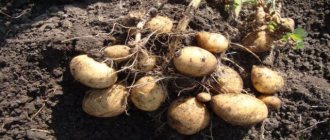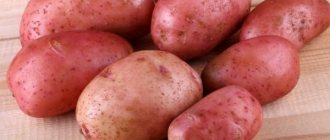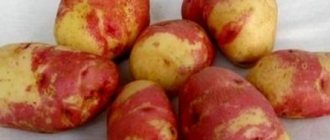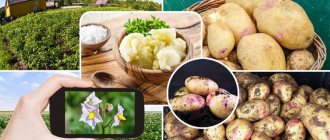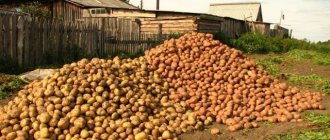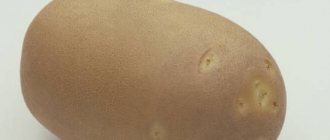Potato Labadia is a table variety bred by Dutch breeders. The originator of the species is agro. The variety was included in the State Register of Russia in 2010 based on the results of tests carried out, which confirmed the declared characteristics. "Labadia" is valued for its large fruit and drought resistance. Potatoes are recommended for cultivation in the Central, North Caucasus, Central Black Earth, Volga-Vyatka, Middle Volga and Ural regions.
The seedlings of this type of crop are of the same type, leveled
Characteristics and description
- General characteristics. Potatoes "Labadia" are varieties of medium ripeness. The weighty tubers characteristic of this species are harvested 75–85 days after germination. Potatoes store well, taste good, and adapt to weather changes and different types of soil. The variety is resistant to many specialized diseases.
- Description of appearance:
- Escape. Potato bushes are tall. The stems are powerful, straight or semi-straight, with a well-developed root system. The foliage is colored in light green shades, slightly wavy at the edges. White flowers form on medium-sized corollas. The shoots are uniform and well leveled.
- Roots. From 6 to 10 tubers are collected from one bush. The peel is slightly rough, yellow in color. The variety is characterized by small eyes. The juicy pulp is yellow-cream when cut.
- Seeding rate and yield per 1 ha. The Labadiya variety is considered consistently productive on all types of soil. The amount of vegetables collected from the beds directly depends on the agricultural technology of cultivation. With regular application of fertilizers, excellent results are achieved. On average, from 29 to 46 tons of potatoes are dug from 1 hectare. The maximum number of varietal vegetables that could be harvested under favorable conditions is 58.3 tons. With the typical planting pattern for the variety (70x35), 14 rows are placed on 1 acre without indentations from the edges. To sow each strip, 28 tubers are needed, which means 392 tubers per hundred square meters. potatoes. With an average weight of 130 g, 5.09 tons of vegetables are used to sow 1 hectare.
- Taste characteristics. Potatoes "Labadia" in accordance with the European classification belong to the varieties of group "B". Table tubers with a slight mealiness are pleasant to the taste. When cooked, they soften a little.
- Chemical composition The degree of starchiness of the variety is 12–16%. Potatoes are considered dietary products. The amount of fat per 100 g does not exceed 0.6%, while a large amount of carotenoids, macro- and microelements, organic acids, and 20% dry matter are noted.
- Average weight of tubers. On average, Labadia tubers weigh from 100 to 145 g. Using competent agricultural technology, it is possible to grow potatoes of 160 g.
- Marketability. The ratio of the number of potatoes sold to the total number of vegetables grown during the season ranges from 89 to 95%. The presentation of the tubers is very presentable.
- Resistance to diseases and pests. “Labadia” is characterized by high immunity to diseases and pests such as:
- Potato cancer.
Wrinkled mosaic.
- Nematode (golden).
The variety has average resistance to:
- striped mosaic;
- viral leaf curl;
- late blight of tubers and tops.
- Central.
Appearance of the variety in Russia, its description
Dutch vegetable growers discovered the Evolution potato in 2011. Four years later, the variety became available to Russian gardeners. Currently, vegetables are grown in most regions of the Russian Federation.
Comparing the crop with other popular types of potatoes, farmers note its tallness. The stem stretches up to 70 cm. The trunks are quite heavily loaded with wide foliage, so they often bend down to the ground. The plant blooms with purple flowers arranged in large inflorescences.
The bush produces from 10 to 20 smooth oval tubers. In the photo you can see that the color of the potato peel is bright pink. Near the shallow eyes the color of the skin is yellowish. The peeled root vegetable has a rich yellow tint. The vegetable is not oversaturated with starch. Its content does not exceed 19%.
| Fruit weight/Yield (per acre) | 80–150 grams/up to 600 kg |
| Tuber shape | Oval |
| Flesh color/Peel color | Rich yellow/Hot pink |
| Ripening period | Early ripening (65 – 85 days) |
| Diseases | Immune protection against nematode, cancer, mosaic. Poor protection against late blight of foliage. |
Characteristics and description
The potato variety Labadia (Labadia) originated in the Netherlands. It is known that Dutch varieties have gained worldwide fame due to their high-quality products. This variety was no exception. Today it is used not only in the West, but also in Russia. The crop was included in the State Register of Selection Achievements in 2012.
Difference from other varieties
The crop is well adapted to drought, heat-resistant and shows high yield on any type of soil, which can be almost doubled with proper processing of the seed.
It is not surprising that the crop is gaining great popularity among vegetable growers.
Composition, trace elements and vitamins
Unlike other vegetables, potatoes are considered a high-calorie product, since 80% of dry matter is starch. But despite this, its benefits are undeniable. The increased content of vitamin C and fiber strengthens the immune system and improves intestinal motility.
A ripe vegetable contains the entire vitamin B complex, including B5 (nicotinic acid), folic acid, as well as proteins and carbohydrates (pectin, glucose, fructose and sucrose). Root vegetables contain potassium and phosphorus salts. The chemical composition is supplemented by organic acids: malic, citric and oxalic.
Reference. Potato skins contain solanine. This is a poisonous glycoalkaloid, which is especially abundant in sprouted tubers.
Description of the plant
The bush is tall, erect, not spreading, with a powerful, well-developed stem. The leaves are large, light green in color. When flowering, the bushes are strewn with large white flowers.
The ripening period is mid-early; 75–85 days pass from the emergence of seedlings to full maturity. Lodging of the tops is observed on the 105th day.
The plant has strong immunity to potato canker, wrinkled mosaic virus, and golden nematode. But moderate resistance to late blight and leaf curl virus is observed.
Characteristics of tubers
The shape is oval-elongated, the average weight is 100–150 g, the fruits are large and even. The peel is creamy yellow with small eyes, the surface is rough. The pulp is pale yellow, the taste is good.
Suitable for universal use: boiling, frying, stewing, baking. Potatoes are also used to produce chips, fries and fast food. When cooking, the fruits can become soft, so they are not brought to full cooking; they are removed from the heat for 3-4 minutes.
The shelf life percentage is high. Up to 97% of finished products retain their appearance for a long time. Transportation is possible over any distance without loss of taste, which is why many farmers are interested in growing this species.
The photo shows Labadia potatoes.
Productivity
A big plus of the plant is its survival rate and rich fruiting on any type of soil. Stable figures characteristic of this variety are 300–450 c/ha. Although with good care and competent pre-sowing treatment, indicators of 550 c/ha were recorded.
One bush produces 7–10 fruits of almost the same size.
Growing regions
The culture is territorially oriented to several regions:
- Ural;
- Volgo-Vyatsky;
- Middle Volga;
- North Caucasian;
- Central;
- Central Black Earth.
Landing dates
Planting dates are determined by the climatic conditions of the region. This is usually the end of April or the first days of May. The main indicator is soil temperature at least +10°C, air temperature - +16–18°C. If heavy rains or recurrent frosts are expected, it is better not to rush with planting. Otherwise, you can ruin all the seed material.
To obtain an early harvest, potatoes are planted under an arc (film), where the necessary conditions are created 2 weeks earlier.
This is interesting! Many gardeners rely on folk signs that indicate planting time. The main ones are: the time when birch leaves have fully blossomed, and the end of bird cherry flowering.
Pests and diseases
"Labadia" is characterized by immunity to golden nematode, wrinkled mosaic and potato cancer. The variety is moderately resistant to leaf roll virus and banded mosaic. In case of unfavorable weather conditions, it may suffer from late blight, and stems and tubers equally. Therefore, when the likelihood of damage increases, it is recommended to carry out preventive treatment of bushes with fungicides at intervals of 10 days.
Labadia bushes can also suffer from the Colorado potato beetle. Therefore, when the first signs of the pest appear, insecticides should be used to prevent mass spread.
Growing and care
Arizona Potatoes
To plant Labadia potatoes in the ground, the area is first prepared. It must be freed from weeds, fertilized and watered thoroughly. After this, holes are dug 10 centimeters deep at a distance of 35 centimeters from each other. In this case, the distance between the rows should be 50-60 centimeters.
To further care for the plant, you need to do the following manipulations:
- loosening;
- hilling;
- watering;
- fertilizer.
Loosening
Potato roots need a lot of air to reach them, because if a crust forms on the surface of the soil and the air supply stops, the tubers stop growing. Excess moisture also affects the growth and formation of fruits. For this reason, periodic loosening is necessary near the potato root system.
Loosening potatoes
For the first time this process should occur after the first shoots. Along with loosening, weeding is done to remove weeds. Then they loosen the ground every time a crust forms, but at the same time make sure not to damage the tops.
Hilling
Potatoes are spudded only when there is sufficient moisture. If you do this during the hot season, there is a high probability of losing a significant percentage of the crop. This procedure is done early in the morning or in the evening. During the growth and development of the plant, it is spudded twice. The first time is when the tops grow by 15 centimeters, the second time - after three weeks.
Watering
Watering Labadia potatoes depends on the climatic conditions in which they are grown. If a sufficient amount of moisture falls in the area where potatoes grow, then they begin to water them during the period of active flowering. It is during this period that the plant requires a lot of moisture. In moderate climatic conditions, potatoes need to be watered three times per season. The first time - after the appearance of the first shoots, the second time - when the buds appear and the last time - after the potatoes have bloomed. If watering is more frequent, an excess of moisture may form in the soil, and this will lead to crop loss.
Fertilizer
Before planting potatoes, any type of soil is fertilized. Then fertilizing is done a month after planting. In this case, fertilizer should coincide with watering. Thus, it will bring more effect to the plant. But it is worth remembering that saltpeter must be added extremely carefully. Otherwise, nitrates will accumulate in the tubers.
Fertilizer application
In order for the plant to develop well and produce a high yield, it is fertilized with a mixture of fertilizers:
- carbamide (urea);
- superphosphate;
- sulfate;
- potassium chloride;
- Bordeaux mixture;
- chicken droppings.
Key points of care
The ripening period depends on various factors: weather conditions and how the vegetable grower cares for the crop. To avoid mistakes, all nuances are taken into account. Labella care measures are standard.
Watering
The bushes are watered during periods of drought, using 10 to 15 liters of water per plant. It is better to water in the evening at the roots. This is necessary so as not to damage the plant, since if you flood the plant in the morning, the sun's rays will leave burns on the leaves.
Fertilizer
Fertilizing plays an important role in growing potatoes. If fertilizers are not applied in time, the plant will not be able to develop normally, but an overabundance will also have a negative impact on the bush.
The best option for fertilizing:
- carry out the first fertilizing during planting (1 tablespoon of the medicine “Solution” or urea per bucket of water);
- perform a second feeding at the beginning of budding (potassium phosphate and ash are diluted in 10 liters of water);
- the third - during the flowering period: it promotes faster formation of potatoes.
Prevention
The Labella variety tolerates late blight epidemics well and rarely suffers from virus damage, but as a preventive measure it is necessary to treat the plant with herbicides.
Every few years the place where the crop is grown is changed. It is good to plant potatoes in areas where legumes or cabbage previously grew. You should not plant root crops in place of peppers or tomatoes.
Growing technology
A great variety of methods and technologies for growing potatoes have been invented - both in bags and in boxes. In general, who is good at what. We will consider only two polar opposite technologies:
- The classic option is growing in open ground.
- An eco-friendly option for the lazy - under the straw on the grass.
In the open ground
Potato planting material has been prepared since the last season, from the moment of harvesting the previous harvest. Before storing the potato crop, it is necessary to select the healthiest, beautiful and even tubers for planting next year. It is not necessary to take very large tubers, but even very small ones will not yield such a great harvest.
Potatoes selected for planting must be stored separately from the main potatoes to prevent the possibility of infection with fungal diseases. The container must be ventilated, but if stored in a dry cellar, the pile storage method is also suitable.
In spring, potatoes are taken out of a cold basement or cellar a week or two before planting and transferred to a warmer place for germination.
Important! It is not necessary to sprout potatoes; you can also plant unsprouted tubers. But sprouted potatoes sprout much earlier
Potato sprouts should be from 10 mm to 50 mm. Too long - 150 mm will simply break off when deepened.
As you probably know, if potatoes are planted from year to year, choosing planting material from the previous year's harvest, over time the potato variety degenerates and the tubers become small. Experts recommend using seed potatoes as part of the planting material to update the variety, which in themselves are not cheap.
But there is another way to update the variety: cut the sprouted tubers into several parts and plant them separately. We will talk about this method.
You can plant potatoes in the ground when the ground warms up to at least +8 - +10 °C. If in your region there are serious spring floods with flooding of the beds, then you will have to wait them out, since potatoes planted in too wet soil will either rot or will certainly produce a sick crop.
This root vegetable loves slightly acidic soil; it grows best on sandy loam and sand, black soil, although a good harvest can be grown on clay or peaty soil.
Before planting, the bed must be loosened to a depth of 20 - 25 cm, removing harmful weeds - wheatgrass, for example. The following is the technology:
We dig a hole with a bayonet shovel 12 - 18 cm deep. We throw a handful of rotted manure to the bottom, kneading it thoroughly and crushing it in our hands.
We take a potato tuber and look at the location of the sprouts. It’s good if there is at least one strong sprout on both sides of the tuber, preferably two. Carefully cut with a sharp knife so that you get two parts of the tuber, each with a sprout or two.
We burn the cut of the tuber with wood ash. To do this, we lower it into a container with ash and carefully, but carefully, scroll there so that there is no empty space left, not covered with ash.
We lower the tuber into the hole so that the sprouts look up.
Sprinkle with soil.
As you can see, there is no special wisdom in planting potatoes. The most interesting thing will begin with the emergence of seedlings.
Growing potatoes under straw
This method of growing is not universally popular among ordinary gardeners, only among those who like to try something new. But adherents of organic farming use this technique to get rid of wheatgrass in virgin lands.
So, to grow potatoes under straw on grass, you need a plot of undeveloped virgin land. Tubers of planting material are laid out on the site in a square-cluster manner. From above, all this is covered with straw in a layer of at least 30 cm. Wooden stakes or other material are placed on the straw so that it does not fly apart.
That's all. During the growing season, this bed is only watered occasionally. Neither hilling, nor loosening, nor weeding, nor even treatment against the Colorado potato beetle is carried out.
Important! The only problem that may arise when growing potatoes this way is mice. But it can be easily solved by having a cat
By the way, many mice did not even breed in straw. As a control measure, elderberry and wormwood branches can be laid out on the straw.
The harvest is harvested in due time. To do this, carefully remove the straw with a pitchfork. There will be potato “pods” under it.
All weeds should be completely rotted under a layer of straw. So next year it will no longer be virgin land, but a clean, fertile bed on which you can grow anything you want.
Characteristics of the variety
Labadia is a mid-early ripening variety that produces a rich harvest of large fruits. The vegetative period is about 75-85 days, lodging of the tops occurs after 105-110 days. The yield of the variety is 300-450 c/ha.
Labadia is geographically oriented for the Central, Central Black Earth, Ural, Volga-Vyatka, Middle Volga and North Caucasus regions.
Potatoes are resistant to increased temperatures and drought, and show consistently good results in various types of soil. When pre-planting treatment of young tubers with biostimulants, it is possible to grow the crop as a double-crop crop.
Description of the plant
Culture meets the following characteristics:
- tall bush, standing straight or semi-straight (relatively sloping);
- stems are powerful, well developed;
- the foliage is large, slightly wavy at the edges;
- the leaves are colored light green;
- corolla medium large;
- white flowers;
- shoots are of the same type, aligned.
Description of the fruit
There are an average of 6 to 10 potatoes per bush of the variety.
- the fruits are large (100-150g), oval-elongated;
- ocelli small, medium deep;
- yellow peel with a rough surface;
- the flesh is creamy yellow;
- starch content is 12-16% of the total mass.
The description of the tuber does not always coincide with what is stated. The reason for this is differences in growing conditions.
Application
Potatoes have an excellent taste and are optimal for baking (separately or as part of other dishes). During the cooking process, it gets a little soft, so it is recommended to reduce the cooking time slightly relative to the standard recipe, or add it to the dish being prepared a couple of minutes later.
Labadia is characterized by good transportability and keeping quality of fruits, which makes the crop an optimal commercial variety.
Proper care will allow you to get a good harvest
The variety is quite unpretentious, but to improve fruit quality indicators and increase yield, the requirements of agricultural technology must be met. Loosening is carried out to improve the air and water permeability of the soil.
Loosening
The potato root system needs more air than other vegetable crops. If there is a shortage of air due to the formation of a crust on the soil or an excess of moisture, plants may stop forming fruits. Therefore, the root zone should always be loosened and slightly moistened.
The first loosening is carried out before germination begins (5-7 days after planting), combined with cleaning the area from weeds
Subsequent procedures are carried out carefully so as not to harm the tops; the time of their implementation depends on the rate of soil hardening (corking)
Hilling
Hilling is carried out exclusively in humid, warm climates. When carrying out the procedure in a hot, dry summer, there is a high risk of crop loss. It is necessary to hill up after watering, early in the morning or late in the evening (when the heat of the day subsides). The procedure is repeated twice until the flowering phase of the plant - at a bush height of 13-15 cm and after 3 weeks.
Watering
The volume and number of waterings depend on the composition of the soil and climatic growing conditions. In rainy weather, water already in the flowering phase (when the crop needs an increased amount of moisture). When there is a lack of moisture, the tops begin to wither and lose their elasticity; the plant requires watering at the rate of 50 liters per m2 (so that the entire fertile layer is saturated with water).
In a temperate climate, the crop will require three waterings per season - after sprouting, when the first buds appear and after flowering. A larger amount will cause stagnation of moisture in the soil.
Fertilizers
It is recommended to apply fertilizers even on the most fertile soil. For the first time, fertilizing is applied 30-35 days after planting, then the application of fertilizers can be synchronized with watering the crop (during the formation of buds and after the end of flowering). You should be careful with the dosage of nitrogen baits (especially nitrate), because they can cause nitrate accumulation in fruits.
For the growth and development of the variety, fertilizing containing:
- carbamide (urea);
- superphosphate;
- sulfate;
- potassium chloride;
- Bordeaux mixture;
- bird droppings.
Advantages
The Labadiya variety has many positive qualities, primarily because it was created recently and meets the needs of modern gardeners.
- The tubers have excellent transportability and shelf life. Keeping quality, that is, storage ability, is about 97%, this is a very good indicator.
- High immunity to common diseases of this crop is also a big advantage. For example, the variety is almost invulnerable to potato nematode, cancer, wrinkled mosaic and leaf curl.
- The Labadia variety is perfect for almost any soil composition and is resistant to drying out, even in this case its yield will be high. After all, potatoes adapt perfectly to soil types.
- The excellent taste of the fruit also cannot be ignored.
Article on the topic: GMO potatoes (transgenic): concept, benefits and harms, varieties
There are no special procedures when planting the Labadia variety. In the fall, it is worth fertilizing the soil with manure, superphosphate or potassium mixtures.
Despite the fact that the variety is quite unpretentious, it still requires care. To achieve the best yield, certain procedures should be carried out regularly:
- loosen the area in order to provide the root system with sufficient oxygen;
- remove weeds regularly;
- water abundantly before the flowering phase;
- during drought, water when the height of the stems reaches 6 cm;
- hill up at a height of about 13 centimeters, then after 2 weeks until flowering (when the weather is hot and the air is dry, hilling cannot be carried out);
- feed.
Potatoes must be planted in soil that has already been warmed to approximately +8ºС to a depth of about 9 centimeters.
It is the latter that is worth special mention. The variety needs feeding even if the soil is of excellent composition and fertile. It is worth fertilizing potatoes after abundant watering. These procedures need to be started when the height of the stems becomes approximately 15 centimeters. You need to treat nitrogen fertilizers, such as nitrate, with special attention and caution. They contribute to the accumulation of nitrates in potatoes. And the following will be useful for feeding:
Standard methods are used to control pests such as the Colorado potato beetle, aphids, potato cutworms and moths. With a small degree of potato damage, harvesting is carried out manually. If pests have spread over a wider area, it is worth using special means.
Over its short period of existence, the Labadia variety has received a very large number of the best reviews. First of all, gardeners note disease resistance. After all, this not only saves time on processing and care, but also helps maintain high yields and the appearance of the fruit.
Summer residents also talk about excellent taste. Housewives note the excellent taste when baking and boiling, and the color of the cooked fruit remains the same light yellow. During the last heat treatment, by the way, the potatoes are well boiled, for this reason the cooking time is shorter than usual.
Anyone who planted this variety once continues to grow it year after year. Many people plant potatoes not only for themselves, but also for sale. After all, “Labadia” has an excellent appearance and taste, and is also well preserved during transportation. Sellers note that this variety sells much better than others.
Based on the description and numerous positive reviews, we can conclude that Labadia potatoes are one of the best varieties bred recently. The combination of all its advantages makes the choice of variety simple and straightforward for many. After all, it has not only attractive properties for cultivation, but also excellent commercial characteristics. All this makes the variety very popular.
To learn how to grow potatoes properly, watch the following video.
Landing
How to prepare the soil for planting potatoes
Experienced potato growers begin preparing the soil immediately after harvesting. Before you dig up the area, clear it of tops. It is better to burn it and fertilize the soil with the ash. In the absence of late blight, the tops can be buried after watering them with a lime solution. You need to dilute 1 kg of dry matter in 10 liters of water.
After this, level the soil to remove small potatoes. Colorado beetles gather on it. Now you can sow the area with white mustard. In October, dig up the area with her. The ideal soil for potatoes has an acidity level of 5.5-6
Pay attention to the weeds
When there is a lot of clover, dandelion, and wheatgrass in the garden, we can say that the land is favorable for planting potatoes.
It is better to plow large areas, but it is more useful to dig up small ones by hand. Do not break large clods of earth. This way the larvae are more likely to die in winter. It is not advisable to add fresh manure; it will not have time to rot and it contains a lot of weed seeds.
For every 1000 kg of rotted manure, add 3-4 kg of potassium-phosphorus fertilizers. Remove weeds by the roots; if left, the rhizomes of the plants will begin to spread vigorously throughout the area.
Do not plant potatoes in one place for 4 years in a row. It is not recommended to plant the crop after tobacco, eggplant, tomatoes, and peppers. Dig up the soil again in the spring and remove the weeds.
Preparing seed potatoes for planting
With proper preparation of potatoes for planting, the yield will increase by 20%. Preparing seeds for planting includes:
- landscaping;
- germination;
- disinfection;
- growth stimulation;
- calibration.
For landscaping, after harvesting potatoes, keep the seeds under a canopy for two weeks. Turn them over every 3-4 days. They will acquire a greenish tint, become more resistant to diseases, etc. Such seeds are stored better.
Potatoes are sprouted at a temperature of at least +15 degrees. Remove it from storage at least a month before planting.
Disinfect the material with a solution of potassium permanganate at the rate of 1 g per 10 liters of water. Use a solution of copper sulfate in a ratio of 10 g of the substance per 10 liters of water. Keep the tubers in the solution for 20-25 minutes before planting.
To stimulate growth, use the drug Poteytin. This increases the germination of the crop by 5-6 days and increases the yield by 10-15%.
Calibration involves selecting seeds of the same size, i.e. caliber.
Learn even more about preparing potato tubers for planting.
Planting dates for the variety
The landing time depends on weather conditions and may change. The earliest time potatoes are planted is in the southern regions of the country, in the middle to second half of April. In the middle zone - in the first half to mid-May. In the Urals, the dates may shift to the end of May
It is important to plant the crop after the soil has warmed up to +8 degrees at a depth of 10 cm. We have already written about how to plant potatoes correctly, we recommend you take a look
Features of growing Colette
Everyone knows that Colleta is a potato variety that can be grown twice per season. Moreover, its yield will be high if properly prepared for planting. The vegetable is planted in the ground, depending on the region. In the south it is typical to start planting at the end of April, but in the north of the country the season begins in the middle and lasts until the end of May.
To get a good harvest, you need to analyze soil moisture and temperature
The absence of frosts is also important, since they greatly affect potato yields.
Preparing for landing
To get a high yield, instructions for proper planting and care must be followed. It is recommended to germinate Colleta potatoes before planting them in the ground. Thus, the time for the development of the bush in open ground will be reduced.
Germination is done as follows:
- seed potatoes are carefully sorted, only healthy tubers are selected;
- for germination, it is best to use boxes where the seed tubers are placed and sprinkled with humus;
- potatoes are laid in layers, between which compost or humus is poured and Gumi is watered;
- the top layer is also covered with compost;
- then the boxes are wrapped in film and placed in a dark, warm place for germination.
Sprouted potatoes are planted in the ground
Advice. When planting potatoes in the ground, it is better to place them sprouts down. This will result in a large spreading bush that will bring a good harvest.
Landing
Potatoes are planted in holes located at a distance of 25 centimeters, into which ash and humus are placed. The distance between rows should be at least 75 centimeters. During the process of potato growth, it is necessary to do weeding and hilling. When the potatoes are ripe, you need to cut off the tops before digging them up.
Loosening
This process must be carried out in order to ensure air flow to the roots of the potato bush and the removal of weeds. The first time the soil is loosened after the first shoots appear. The hoe should not go deeper than one and a half centimeters in depth. During the growth process, loosening can be carried out in parallel with hilling.
Hilling
To get a good harvest, this process must be done several times.
The first hilling should be carried out immediately after germination. In this case, the potatoes can be covered with soil.
This way, the sprouts will not freeze at night, when the air temperature is still significantly lower. Before the first flowering, it is recommended to “burn” the potatoes two more times.
Watering
It is done if the summer is hot and it rains very rarely. Soil moisture is very important for potatoes, but you need to have a sense of proportion and not over-wet the soil.
Top dressing
For feeding, mineral fertilizers such as Nitrophoska are used. Fertilizer is applied for the first time when it becomes noticeable that the potato bushes are weak, the stems are thin, and the leaves have lost their color saturation. Subsequent application of fertilizers is carried out every ten days.
The first shoots of Colette potatoes
Potato varieties
Due to the fact that this root vegetable is almost the bread of our country (it is really called the “second bread”), there are a great many varieties of it, which are constantly increasing, every year by 10–15 pieces. The characteristics of potato varieties can be found on many sites dedicated to their cultivation, so in this article I will try to talk only about some varieties that are not mentioned in them or are rarely mentioned.
Reward
– an early ripening variety with very large yellow tubers (up to 300 g), which can be stored for a long time without germinating. It is resistant to diseases such as potato cancer, and slightly less resistant to late blight.
Chernigov souvenir
– mid-early variety, the tubers are large (250 – 300 g), yellow in color with a rough mesh. The pulp is also light yellow and does not darken during cooking. The taste of potatoes of this variety is excellent; the root vegetables are suitable for baking or mashing. It can be stored for a long time. Resistant to potato blight and common scab.
Zoryana
– mid-season variety, large tubers (250 g) white with a rough mesh. The pulp is snow-white and crumbly when cooked. Stores very well, tastes excellent. Resistant to the following diseases: potato canker, common scab, and slightly less resistant to late blight. Thanks to its hard leaves, it is less damaged by the Colorado potato beetle.
Red Fantasy
– mid-early variety, tubers of medium and large size, elongated oval shape, smooth red skin. The pulp is yellow, does not darken when cooked, and is very tasty. Resistant to: nematodes, potato blight, blackleg and other viruses, relatively resistant to common scab and late blight.
Annushka
– mid-early variety, tubers are mostly medium and large in size, the skin is brilliantly yellow, the flesh is also yellow, very tasty. The tubers are stored well and do not germinate ahead of time. It is resistant to nematodes, potato cancer, viruses and common scab, but to prevent Alternaria blight it requires timely treatment with fungicides.
Labadiya
– mid-early variety, large tubers, yellow in color, pulp too. Particularly tasty when baked and boiled. Resistant to potato blight and golden nematode.
Ramos
– mid-early variety, drought-resistant. The tubers are very tasty; they do not get soft when cooked, so they are suitable for making French fries. It can be stored for a very long time even at low temperatures. Resistant to mechanical damage, viruses and golden nematode.
Aladdin
– mid-season variety, very tasty tubers with a high content of starch and dry matter. The shape of the tubers is round-oval, the skin is red, rough, the flesh is white - it is slightly boiled. Stores very well and is not prone to early germination.
Among all the variety of varieties included in the register, it’s not surprising to get lost. Breeders in each region consider it their duty to come up with a new variety adapted to specific growing conditions
Therefore, when choosing, pay attention to the resistance of the variety to certain diseases in the region, high humidity or drought.
Positive and negative sides of Labadia
Labadia potatoes have a number of positive aspects, thanks to which the variety is valued both in the market and among summer residents. Among the main advantages it is worth noting:
- Excellent commercial quality: large tubers, uniform in shape. Potatoes are not afraid of transportation and are stored for a very long time.
- Good taste.
- High and stable yield.
- Labadia is not afraid of short-term droughts, and also adapts well to various types of soil.
- It has a relatively strong immune system that protects against a number of fungal diseases.
At the same time, we should not forget about Labadia’s shortcomings. These include:
- Tubers germinate very poorly, which creates the need for preliminary germination.
- Root crops are afraid of frost.
How to choose seed potatoes
You can purchase or order seed potatoes almost anywhere, from a spontaneous market to direct sale in a garden center. It is worth saying that vegetables are usually sold in nets made of woven material, which plays into the hands of the buyer. The fact is that in this case you can clearly see all the shortcomings and disadvantages, such as rotten vegetables, cuts or chips on the crop. If there are any, it is better to choose another bag.
It is worth saying that buying on a spontaneous market may turn out to be extremely unprofitable for you. There is no way for you to know for sure which potatoes are in the net. It may very well be that what you are looking at is not a seed potato, which belongs to the first or even the second reproduction, but one that has already degenerated or is affected by parasites or diseases. From this point of view, it is worth purchasing potatoes at specialized points of sale of an agricultural company, where each grid will have a certificate indicating the name of the variety, as well as information about the order of reproduction. In addition, the company often includes information about care, propagation and cultivation with the net, and also grows potatoes to order.

